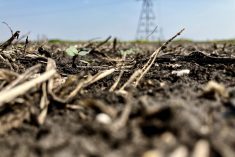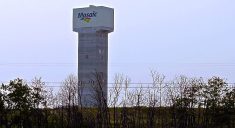CNS Canada — Seasonal challenges are popping up for fertilizer users this spring, according to the president of Manitoba’s Keystone Agricultural Producers — but Dan Mazier says they’re not your typical ones.
“The supply seems to be all right; definitely anhydrous ammonia is available,” he said.
However, he’s heard some reports that this year’s phosphate is too “thin” but he thinks that could be related to storage issues.
“When you need it, it’s really too late to worry about quality issues; that adds for a bit of extra stress,” he said.
Read Also

U.S. livestock: Cattle mixed on technicals, profit taking after tight supply rally
Chicago | Reuters – Chicago Mercantile Exchange cattle futures ended mixed on Wednesday as tight supplies and higher choice beef…
The real issue that’s flabbergasted him so far this year is how badly local roads have been beat up from spring trucks delivering fertilizer to farms.
“We have frost boils all over the place from trucks trying to deliver spring fertilizer; I can’t get over the damage it does,” he said.
Getting fertilizer doesn’t appear to be a problem right now, but damage to roads has him and others thinking more about long-term storage solutions.
“A lot of guys are rethinking the spring application of fertilizer; maybe the fall application of fertilizer isn’t such a bad deal,” he said.
As for storing fertilizer off-farm, Mazier said there are challenges with that as well.
“Some dealers will actually charge you for storage if you don’t use it all. Anhydrous is tricky; guys usually buy it up early,” said Mazier.
As far as prices go, nitrogen fertilizer (82-0-0) is around $1,000 a tonne right now — about $250 higher than in the fall, according to Mazier. Urea is around $650 a tonne, but producers should have pre-booked by now to ensure delivery.
A few months ago, there were rumours about a looming shortage of ammonia sulphate, the prime fertilizer used by canola growers. It appears there will be enough after all, Mazier said.
“I think the phosphate is pretty well in position and urea is in position,” he said.
In the U.S., there has been a massive run on fertilizer recently with the surge in corn planting over the past 10 days, according to David Asbridge, president and senior economist with NPK Fertilizer Advisory Service in Missouri.
“There’s a spot shortages of fertilizer, particularly phosphate, in the eastern Corn Belt,” he said. “Dealers were hesitant to order replacement tonnes because it had been so wet and so late over there; they were concerned they weren’t going to have much of a season.”
However, he said, the run on supplies in the eastern U.S. is far enough away for Canadian farmers to be relatively unaffected.
— Dave Sims writes for Commodity News Service Canada, a Winnipeg company specializing in grain and commodity market reporting.















